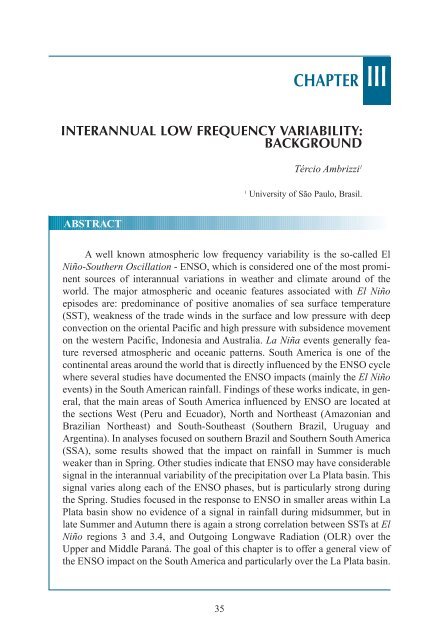chapter - Atmospheric and Oceanic Science
chapter - Atmospheric and Oceanic Science
chapter - Atmospheric and Oceanic Science
Create successful ePaper yourself
Turn your PDF publications into a flip-book with our unique Google optimized e-Paper software.
A well known atmospheric low frequency variability is the so-called El<br />
Niño-Southern Oscillation - ENSO, which is considered one of the most prominent<br />
sources of interannual variations in weather <strong>and</strong> climate around of the<br />
world. The major atmospheric <strong>and</strong> oceanic features associated with El Niño<br />
episodes are: predominance of positive anomalies of sea surface temperature<br />
(SST), weakness of the trade winds in the surface <strong>and</strong> low pressure with deep<br />
convection on the oriental Pacific <strong>and</strong> high pressure with subsidence movement<br />
on the western Pacific, Indonesia <strong>and</strong> Australia. La Niña events generally feature<br />
reversed atmospheric <strong>and</strong> oceanic patterns. South America is one of the<br />
continental areas around the world that is directly influenced by the ENSO cycle<br />
where several studies have documented the ENSO impacts (mainly the El Niño<br />
events) in the South American rainfall. Findings of these works indicate, in general,<br />
that the main areas of South America influenced by ENSO are located at<br />
the sections West (Peru <strong>and</strong> Ecuador), North <strong>and</strong> Northeast (Amazonian <strong>and</strong><br />
Brazilian Northeast) <strong>and</strong> South-Southeast (Southern Brazil, Uruguay <strong>and</strong><br />
Argentina). In analyses focused on southern Brazil <strong>and</strong> Southern South America<br />
(SSA), some results showed that the impact on rainfall in Summer is much<br />
weaker than in Spring. Other studies indicate that ENSO may have considerable<br />
signal in the interannual variability of the precipitation over La Plata basin. This<br />
signal varies along each of the ENSO phases, but is particularly strong during<br />
the Spring. Studies focused in the response to ENSO in smaller areas within La<br />
Plata basin show no evidence of a signal in rainfall during midsummer, but in<br />
late Summer <strong>and</strong> Autumn there is again a strong correlation between SSTs at El<br />
Niño regions 3 <strong>and</strong> 3.4, <strong>and</strong> Outgoing Longwave Radiation (OLR) over the<br />
Upper <strong>and</strong> Middle Paraná. The goal of this <strong>chapter</strong> is to offer a general view of<br />
the ENSO impact on the South America <strong>and</strong> particularly over the La Plata basin.<br />
35<br />
CHAPTER<br />
INTERANNUAL LOW FREQUENCY VARIABILITY:<br />
BACKGROUND<br />
ABSTRACT<br />
Tércio Ambrizzi 1<br />
1 University of São Paulo, Brasil.<br />
III






